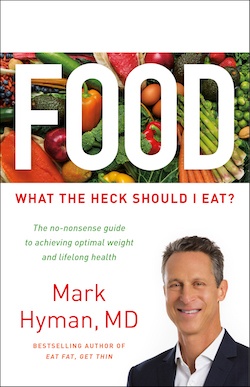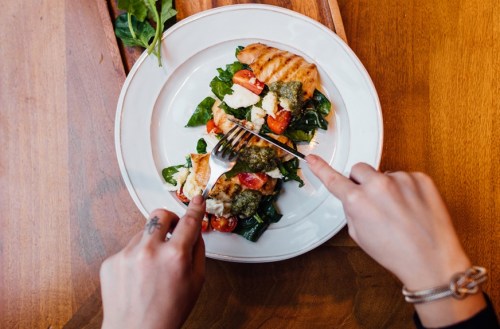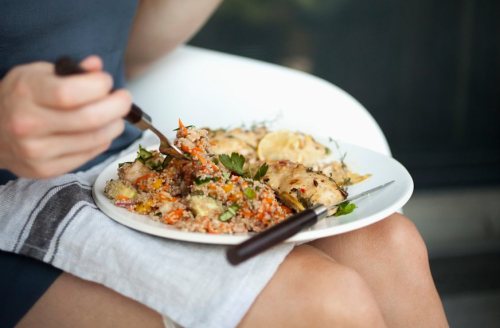Our editors independently select these products. Making a purchase through our links may earn Well+Good a commission
Everything you need to know about the pegan diet
Dr. Mark Hyman explains the health benefits of the pegan—Paleo-vegan—diet.


There’s a reason Facebook groups for various eating plans, like the ketogenic diet, Whole30, or Weight Watchers attract so many followers: Your fellow dieters are your tribe in the same way that yogis, Crossfitters, and people with a Peloton bike have their tribes. It’s a lifestyle thing that bleeds beyond the actual plan to affect your total well-being.
If you’ve spent any time perusing various food blogs and forums, you know that Paleo and vegan groups are two of the most passionate. Which is why it’s so interesting that a hybrid of the two—a “pegan” diet—is what Food: What the Heck Should I Eat author Mark Hyman, MD, (one of the most in-demand doctors in the biz) recommends to all his patients.
“As a doctor, it’s my job to figure out the best way to keep my patients healthy,” he says. “We now know that food is medicine—perhaps the most powerful drug on the planet—with the power to cause or cure most disease. If food is more than just calories, if food is information that controls every aspect of our biology and health, then I better know what to advise people [to eat] to prevent, treat, and even reverse chronic disease.”
But why go “pegan”? How does one even do that?
Scroll down for all the facts about going pegan.

Why go pegan?
First things first: Why not just stick to one or the other, Paleo or vegan? Why the mashup? “On the one hand, [NBA superstar] LeBron James is eating Paleo. But on the other hand, Rich Roll completed five Iron Man marathons in seven days on a vegan diet,” Dr. Hyman says, adding that scientific research also gives conflicting evidence on which lifestyle is best. “Vegan diet studies show it helps with weight loss, to reverse diabetes, and to lower cholesterol. Paleo diets seem to do the same thing. So should you be shunning animal foods and eating only beans, grains, and veggies—or should you eat meat and fat without guilt and give up all grains and beans?”
He explains that often, people champion scientific evidence that matches up with what they already believe. But most people, he says, don’t look at the studies on a deeper level—they often just look at the headline and call it a day. But because he geeks out on reading medical journals and research, Dr. Hyman digs deep when looking at the results.
“On the one hand, LeBron James is eating Paleo. But on the other hand, Rich Roll completed five Iron Man marathons in seven days on a vegan diet.”
One key issue Dr. Hyman’s found with these studies (which may account for the split recommendations) is that many are done with very small sample pools, making it hard to draw firm conclusions that can be applied to the masses. “Even worse is that the diets they use for comparison—the control group—are not ideal alternative diets,” Dr. Hyman says. “Comparing a vegan diet of chips, soda, bagels, and pasta to a Paleo diet of healthy veggies and grass-fed meat won’t be very helpful, nor would comparing a Paleo diet of feedlot meat, bologna, and no fresh veggies to a whole foods, low-glycemic vegan diet.”
This conflicting research based on less-than-ideal scenarios led Dr. Hyman to use his medical know-how to prescribe his own way of eating that combined the best of both worlds. Enter, the pegan diet.

How to eat pegan
Eating pegan is essentially taking the healthiest parts of both diets and combining them: “A pegan diet is low-glycemic, high in plant foods, low in sugar, and includes adequate protein for appetite control and muscle synthesis,” Dr. Hyman explains.
He also adds that each person should tweak it to fit their own particular health conditions, preferences, and needs. “If you’re vegan and don’t want to eat anything with a mother for moral or religious reasons, then that’s perfectly okay. But it’s critical to get omega-3 fats, and not just ALA (or alpha-Linolenic acid) found in plants,” he says. This is because “you need pre-formed DHA, which is what most of your brain is made from. The good news: You can get it from algae.”
Dr. Hyman’s new book is full of pegan recipes, like pesto frittata, grilled salmon with parsley-walnut butter, and spinach falafel. Another one of his go-tos is an herb and avocado omelette, which he shows how to make in this video. It’s proof the two eating styles can play nicely after all.
For more of Dr. Hyman’s advice, find out why you should detox before starting a new diet. Plus, everything you need to know about the buzziest eating plans.
Sign Up for Our Daily Newsletter
Get all the latest in wellness, trends, food, fitness, beauty, and more delivered right to your inbox.
Got it, you've been added to our email list.










